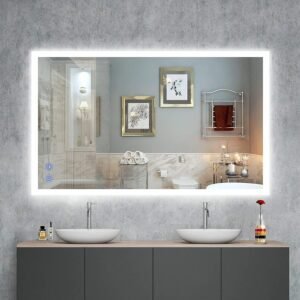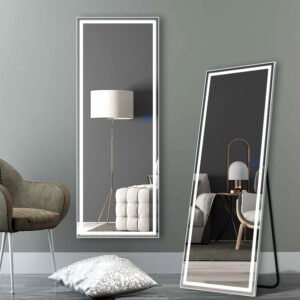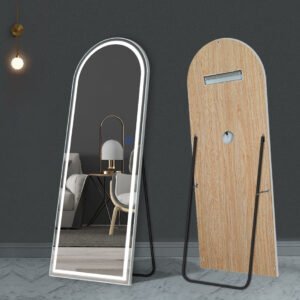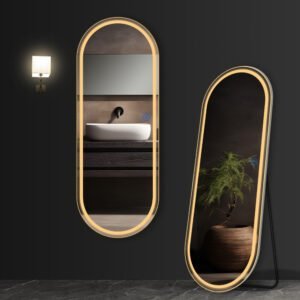Incorrect wiring can cause LED bathroom mirrors to malfunction or become harmful. How to wire a bathroom mirror? This article will teach you the proper wiring strategies to guarantee that your LED mirror performs securely and efficiently.
To wire an Miroir de salle de bain LED correctly, turn off the power, connect the live, neutral, and ground wires, and secure them with wire connectors. Ensure proper insulation and use a waterproof junction box if necessary. Test the mirror once the power is restored.
Here’s a step-by-step instruction for securely and effectively wiring an LED bathroom mirror.

Table des matières
BasculerWhat Are the Power Requirements for an LED Bathroom Mirror?
The first and most important step in installing an LED bathroom mirror is to understand its power needs. Most LED mirrors work between 110V-220V, making them compatible with a broad range of electrical systems available in various locations. Cependant, before proceeding with any LED mirror installation, ensure that your electrical infrastructure can handle the mirror you’re utilizing. Par exemple, a battery-powered LED bathroom mirror may not need an electrical connection, but a hardwired LED mirror must be directly connected to your home’s electrical system.
Some modern Miroir LED models, especially those with extra functionalities like backlit mirrors, defogging mirrors, or touch-sensitive controls, may require a transformer. The converter converts alternating current (AC) into direct current (DC), which powers the LEDs. This is especially crucial for mirrors that require a steady and regular power supply to preserve the quality and lifetime of their LED bathroom mirror light.
When wiring a vanity mirror with lights or a light up cosmetic mirror, always consult the manufacturer’s handbook to determine the necessary voltage. Incorrect voltage can destroy the LED mirror with lights while also posing severe electrical concerns. To avoid issues, ensure that your mirror’s specs match the power supply for bathroom mirror.
When installing an LED light mirror vanity or any other mirror with LED lights, you must first ensure that it is compatible with your home’s electrical supply. Using the incorrect voltage might result in mirror bathroom light failure and associated fire dangers.

What Tools and Materials Are Needed for Installation?
To wire your LED bathroom mirror, you will need a few equipment and supplies. Using the right equipment will not only ensure a safer installation, but will also help you get the greatest results when installing a back lighted mirror or vanity mirror with LED lights. Here’s everything you’ll need:
- Screwdriver: This is required to fasten the mirror with lights to the wall or any mounting brackets. A Phillips-head screwdriver is typically the recommended tool.
- Wire strippers: Use these to remove the insulation from the ends of electrical cables. This step is critical for establishing clean, secure connections when connecting to the LED bathroom mirror wiring schematic.
- Electrical tape: Used to seal wire connections and add insulation to prevent short circuits from occurring.
- Wire Connectors: These are used to securely connect electrical wires and avoid loose connections that might cause electrical failures.
A voltage tester is a vital instrument for ensuring that the power is switched off before beginning your task. This guarantees that no current flows through the wires, avoiding unintentional shocks during installation. When putting miroir de salle de bain lights in humid environments like bathrooms, it is also advised to use a waterproof junction box. Moisture may destroy electrical components over time, but selecting a waterproof component improves durability and safety.
Waterproof components and high-quality electrical materials are essential for placing mirrors in high-humidity situations such as bathrooms. Battery LED bathroom mirror setups may require different specifications than hardwired LED mirror installations.

How to Properly Connect the Wires?
Now that you have all of the essential equipment, it’s time to connect the wires correctly. To avoid errors that might lead to electrical risks or malfunctions, pay close attention to the wiring procedure for your LED bathroom mirror light. Here’s a step-by-step tutorial on making a secure and safe connection:
- Identify the wires: Start by identifying the live (L), neutral (N), and ground (G) fils. The live wire is commonly black or red, the neutral wire is white, and the ground wire is green or bare copper. If you’re installing an Miroir de vanité conduit, these wire types are common in most bathroom mirror configurations.
- Connecting the wires: Using wire nuts or terminal blocks, connect the live wire to the appropriate mirror terminal, the neutral wire to the neutral terminal, and the ground wire to the ground terminal. Check that each connection is tight and secure to avoid any shorts or electrical issues.
- Securing the connections: After connecting the wires, cover the exposed ends with electrical tape to add insulation. This is especially critical in restrooms, where moisture may easily jeopardize wire safety.
Use only high-quality materials, especially when dealing with an LED light mirror vanity. When you choose LED mirror suppliers or LED mirror manufacturers, you can be confident that you are using approved components for the greatest outcomes. Follow the LED bathroom mirror wiring schematic and regulations for bathroom LED mirrors. Incorrect wiring can cause short circuits, sparks, and fires.

How to Perform a Safety Check and Testing?
Once all cables are connected, run a full safety check. Before reconnecting electricity, double-check all wire connections to verify there are no exposed wires or loose connections. This step is critical when working with backlit bathroom mirrors or any mirror with LED lights, as a bad connection may prohibit the mirror from functioning correctly or represent a safety issue.
- Test the wiring: Before reconnecting power, check the wiring using a voltage tester to ensure it is not live. This guarantees that you are working in a safe atmosphere and avoids unintentional electrical shocks.
- Test the mirror: After restoring power, make sure your LED light mirror vanity or backlight mirror is working properly. Check the LED lighting and any other features, such as the defogging mirror or touch-sensitive controls, to ensure that everything works properly.
Enfin, use a circuit breaker as an extra safety precaution before undertaking any electrical repair. If there is a malfunction, the circuit breaker will turn off the power to protect your LED bathroom mirror light and the electrical system. When completing safety inspections, make sure to be thorough. LED mirrors frequently come with extra features, such as a magnifying mirror with light, which should also be inspected to guarantee proper operation.

What Are Common Wiring Mistakes and How to Avoid Them?
Even skilled DIYers might make blunders when wiring an LED mirror with lights or cosmetic mirror with lights. To avoid these mistakes, it’s important to be aware of the most typical concerns.
- Incorrect wire connections: One of the most common faults is mismatching the live, neutral, and ground wires. This can cause an electrical short or the mirror bathroom light to malfunction.
- Inadequate grounding: Failure to correctly ground your Miroir de salle de bain LED can lead to harmful electrical shocks, especially in damp areas such as restrooms.
- Using the incorrect voltage: Always check that the voltage parameters on the LED vanity mirror correspond to your home’s electrical system. Using the incorrect voltage might burn out your LED mirror or cause serious electrical issues.
To avoid these problems, refer to the LED bathroom mirror wiring schematic that came with your purchase. If you are unsure about the wiring, you should always contact with an expert electrician. Before installing your bathroom mirror, make sure it is compatible with the power source in your home. Using a high-quality Usine miroir LED assures that the LED light mirror meets all safety specifications. Wiring requirements for bathroom installations must always be followed to avoid errors.

How to Ensure Long-Term Safety After Installation?
The safety of your LED bathroom mirror does not end with the installation. Regular maintenance and safety tests are required to assure its long-term safety:
- Inspect connections regularly: Wires can loosen and connections can weaken with time, so inspect them on a regular basis. Check the wiring on a regular basis to ensure that everything is secure and operating properly.
- Use GFCI outlets: If your mirror is situated in a bathroom, it should always be connected to a GFCI outlet. These outlets turn off electricity if there is an electrical fault, giving further safety against electrical shocks.
En plus, keep your backlit bathroom mirror dry and moisture-free. Moisture can harm electrical components over time, particularly in high-humidity environments such as bathrooms. Long-term safety necessitates the use of high-quality materials and attention to safety guidelines. Using approved LED light up makeup mirrors and adhering to suitable LED mirror installation procedures assures safe functioning.

Can You Power a Bathroom Mirror from a Shaver Socket?
Many bathrooms contain shaver outlets, which are used to power low-wattage equipment such as razors and toothbrushes. While these plugs appear to be a simple option for powering a mirror with LED lights, they are often insufficient for the increased wattage required by LED bathroom mirrors.
A battery Miroir de salle de bain LED may be an exemption because it does not require direct electrical connections. Cependant, if you try to use a shaver socket for a high-power LED vanity mirror, you risk overloading the socket and destroying the mirror or the socket itself.
Before using a shaver socket, always verify the wattage needs of your LED bathroom mirror. If your mirror is battery driven, this is unlikely to be an issue, however, hardwired LED mirrors require more power than a standard shaver socket can give.

How Much Does It Cost to Install a Bathroom Mirror?
The cost of installing an LED light mirror vanity or backlight mirror varies depending on numerous factors. If you choose a DIY installation, the expenses are often lower because you simply need to buy the essential equipment and supplies. Hardwired LED mirrors, d'autre part, need extensive electrical work and should be installed by an expert. Professional installation might cost anywhere from $100 à $500, depending on the intricacy of the task.
Simpler solutions, such as those employing battery-powered LED mirrors, may cost far less. Even in these circumstances, employing a professional may help verify that the installation follows local wiring rules and is completed properly. When selecting a vanity mirror with LED lights, keep the expense of professional installation in mind, especially if your mirror requires a power supply for bathroom mirrors that require specific wiring.
Do You Need an Electrician to Install an LED Bathroom Mirror?
When it comes to installing a hardwired LED mirror, it is nearly always advisable to engage a qualified electrician. While battery LED bathroom mirrors may typically be installed by homeowners, hardwired LED mirrors need direct contact with your home’s electrical system, which can be dangerous if done incorrectly. A professional electrician will guarantee that all connections are secure, code-compliant, and safely placed. Hiring a professional guarantees that your LED mirrors are correctly grounded and meet local wiring codes.
Les miroirs LED sont-ils sûrs?
Oui, LED mirrors are typically safe when properly designed and fitted. They use low-voltage LED illumination, which is safer than typical incandescent or fluorescent bulbs. Most high-quality LED mirrors have safety certificates such as UL, CE, ou ETL, indicating that they fulfill industry requirements for electrical safety.
One of the most important safety features of LED mirrors is their anti-fog function, which prevents condensation development in humid situations such as toilets. En outre, many versions have shatterproof or tempered glass, which reduces the danger of damage if the mirror breaks.
Proper installation is critical to safety. Wall-mounted LED mirrors should be securely fastened, and electrical connections must adhere to local standards. If the mirror is hardwired, expert installation is advised to avoid wiring problems. LED mirrors also emit very little heat, making them safer than traditional lighting alternatives. They are energy-efficient and have a long lifespan, avoiding the need for frequent replacements, which might pose handling hazards.
Résumé
A properly wired LED bathroom mirror assures both performance and safety. To avoid electrical problems, observe voltage recommendations, secure connections, and complete comprehensive safety inspections. Always follow local wiring codes and guarantee your LED mirror is compatible with your home’s electrical system.










